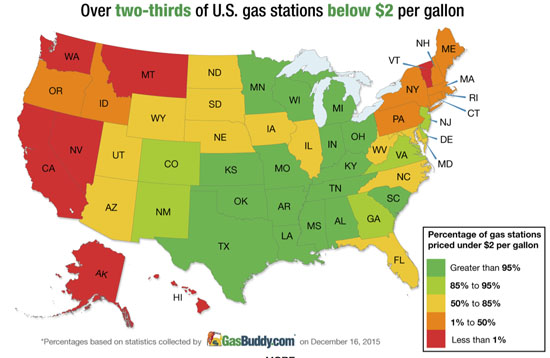U.S. gas price ave. falls below $2 a gallon
Gasoline price information
For the first time since March 25, 2009, the national average price of gasoline has dropped below $2 a gallon, while Ohio gasoline prices continue to fall.
 Currently over two-thirds of gas stations are selling gasoline at $1.99 or less, yet the national benchmark had previously failed to breach $2 a gallon as fuel prices have been stubbornly slow at dropping in the West and new refinery issues there may soon lead the national average back up.
Currently over two-thirds of gas stations are selling gasoline at $1.99 or less, yet the national benchmark had previously failed to breach $2 a gallon as fuel prices have been stubbornly slow at dropping in the West and new refinery issues there may soon lead the national average back up.
For now, with the recent decline in crude oil prices continuing, the weeklong $2 barrier has finally been crossed.
It was not a matter of whether it could happen, but when; various factors have pushed global crude oil prices consistently lower, fuel supply in much of the country has been higher and consumer demand has been unremarkable. There is more good news on the horizon for those who enjoy the low prices: many areas will see them stick around for a good portion of the winter.
Thirty states now have an average price below $2 and another five states (Maryland, Illinois, New Hampshire, Florida, and Utah) are poised to join the club within days as the momentum has brought their respective averages within a nickel of $2 a gallon. Only 33 percent of the nation’s gas stations have prices over $2 a gallon and just three states have zero gas stations under that level: Hawaii, California and Nevada.
“Yesterday we saw the benchmark crude in the U.S. — West Texas Intermediate crude oil (WTI) — slip below $35 per barrel and that is certainly reflective of global inventories and production at lofty levels,” said Patrick DeHaan, senior petroleum analyst for GasBuddy, late last week. “The Organization of the Petroleum Exporting Countries’ inactions continue to benefit motorists with cheap gasoline prices, but consumers should be skeptical of some OPEC members seeking to capture market share by pressuring prices down to a point where some U.S. producers are forced offline by low prices.”
“Nonetheless, for the vast majority of consumers the gasoline price decline is a blessing that provides a little extra cash when it’s most needed,” DeHaan added.
Here in Ohio, average retail gasoline prices have fallen 10.2 cents per gallon in the past week, averaging $1.81 per gallon on Sunday, according to GasBuddy’s daily survey of 5,345 gas outlets in Ohio. This compares with the national average that has fallen 1.6 cents per gallon in the last week to $1.99 a gallon, according to gasoline price website GasBuddy.com.
Including the change in gas prices in Ohio during the past week, prices Sunday were 39.4 cents per gallon lower than the same day one year ago and are 3.8 cents per gallon lower than a month ago. The national average has decreased 8.4 cents per gallon during the last month and stands 39.4 cents per gallon lower than this day one year ago.
“With the national average price of gas slipping below $2 on Saturday, the holiday season continues to reward most consumers at the pump, but the Grinch turned up in California, replacing price declines with price spikes,” said Gregg Laskoski, a senior petroleum analyst with GasBuddy. “California’s hikes tie directly to issues at two refineries with combined capacity exceeding 400,000 barrels per day. Consequently, California’s average price has climbed by 8 cents per gallon while the rest of the country for the most part sees declines,” Laskoski said.
For a complete listing of current averages and other fuel price data, visit http://media.gasbuddy.com. For fuel news and alerts, follow @GasBuddyNews on Twitter.
How low will prices go in the U.S.?
“It’s likely that gasoline prices will eventually decline even further into early January as demand bottoms out, but, eventually the party comes to an end,” DeHaan said. “That’s because demand will begin to climb approaching the spring, as well as federal regulations that require refineries to shift from winter-blend gasoline to summer blend. Refinery maintenance also leads to capacity going offline — capacity that is relied on to boost supply just as demand is rising.”
And like clockwork, first-quarter retail prices tend to climb rapidly as this annual exercise tightens supply and consumer demand concurrently rises, but before that happens consumers might see the national average bottom out at $1.85,” DeHaan concluded.
POSTED: 12/21/15 at 8:18 am. FILED UNDER: News







